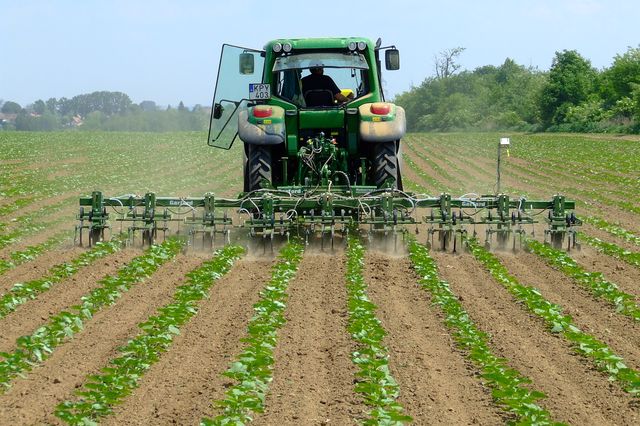Significance of growing area, crop rotation and soil tillage technologies in medicinal plant production
Authors: Beáta Gosztola, László Varga, Hella Simkó
Selection of optimal growing site
Concept of growing site
The growing site is the place of cultivation, the environment, which provides the living conditions for cultivated plant species. It includes the growing area’s natural (ecological) and economic endowments too. During cultivation the basic aim is to satisfy the biological needs of plant species as much as possible, because optimal crop yield can be reached only this way. Plant of good condition is also much more resistant to pests, pathogens or adverse weather conditions. On an unfavourable growing site it’s impossible to achieve competitive production.
Interesting connection, however, that adverse environmental conditions (stress factors) can result in a higher active substance content in case of some medicinal plant species. For example, the light-demanding common goldenrod (which likes the more acidic, loose structured soils) cultivating on a high calcareous, alkaline soil and in shade had higher total flavonoid content than under ideal environmental conditions. The main reason of this is that effect of stress the plants’ metabolism changes and certain biosynthetic pathways start to produce the secondary metabolites more intensively. Naturally the biomass production of plants cultivated under unfavourable conditions won’t be optimal.
Determinative ecological factors of growing site
Latitude, altitude (light and temperature conditions)
Latitude and altitude influence the intensity of solar radiation, hereby the light supply and temperature considerably. At different latitudes the incidence angle of solar radiation is different, it decreases from the Equator towards the Poles, so the same amount of radiation energy is distributed over a larger surface. Thus, the radiation energy and in this way the warming of Earth's surface is decreasing moving away from the Equator. Altitude also affects light supply, because moving away from sea level the thinner atmosphere can transmit more and more solar radiation. But temperature decreases upwards, approximately 0.5°C per every 100 meters.
Hungary is located at the height of 46 and 48° latitude, but it is very varied in terms of temperature and light conditions because of its topography. The southern part of the Great Hungarian Plain is the sunniest (more than 2100 sunny hours/year), and the least amount of sunlight is experienced in the Hungarian part of the Alps (less than 1800 sunny hours/year). The highest temperatures are measured in the south-east part of the Great Plain, here in July the average temperature is more than 22°C, and the coldest areas are in the North Hungarian Mountains (the average temperature is 18°C in July). The pattern of heat sum values in the vegetation period is also similar. In case of perennial or overwintering plant species the temperature conditions of winter are also very important (e.g. number of frost days, minimum temperature values, winter temperature fluctuations).
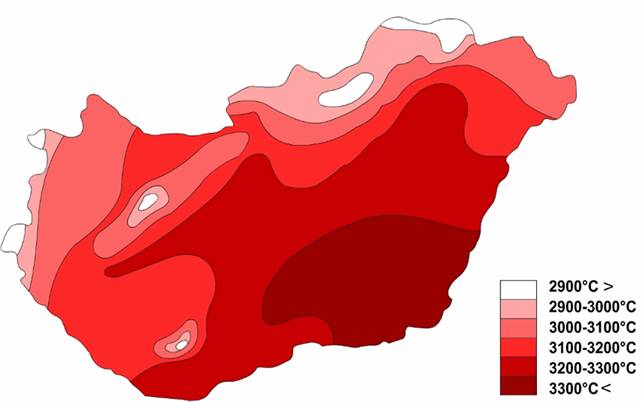
Heat sum of the vegetation period in Hungary
Because of this high meteorological heterogeneity both warm-demanding (e.g. Calendula officinalis, Chrysanthemum cinerariaefolium,Cucurbita pepo var. styriaca, Lavandula species, Majorana hortensis, Malva sylvestris subsp. mauritiana, Ocimum basilicum, Ruta graveolens, Salvia officinalis, Salvia sclarea, Satureja hortensis, Silybum marianum, Thymus vulgaris, Trigonella foenum-graecum) and moderately cold-demanding species (e.g.Angelica archangelica, Carum carvi var. biennis, Hyoscyamus niger, Hippophae rhamnoides, Humulus lupulus, Verbascum phlomoides) can be grown in Hungary. But we can cultivate them successfully in different parts of the country: warm-demanding species mainly in the southern parts (e.g. Tolna, Baranya, Bács-Kiskun, Csongrád, Békés county) while moderately cold-demanding ones in the northern regions. Winter poppy can be grown most safely in the north-west of Hungary, because the fluctuation of winter temperature there is the smallest, therefore the risk of frostbite is very low.
Since temperature and light supply are kind of environmental factors which can’t be influenced by agrotechnical methods or only hardly (e.g. using of adequate planting space, cultivation of breeded varieties, active or passive frost protection, etc.), we should pay very much attention to them during growing site selection.
Topographic conditions
The exposure of the area, it’s height relative to the environment, the slopes’ steepness, the nearness of low-lying areas also influence the light and temperature conditions of growing place, hereby the living circumstances of cultivated plant species. In the northern hemisphere the south-facing slopes are warmer than the north-facing ones because of the greater incidence angle of solar radiation. Artemisia absinthium, Hyssopus officinalis, Salvia officinalis, Thymus spp., Lavandula officinalis like the south-facing, sunny, warm hillsides, because they are light- and heat-loving species. Thus it is no coincidence that lavender cultivation evolved in the region of Lake Balaton on the southern slopes of Tihany peninsula. In case of some medicinal plant species (e.g. Chrysanthemum cinerariaefolium, Majorana hortensis, Pimpinella anisum, Rosmarinus officinalis) it is particularly important to select frost protected growing sites. At marigold cultivation the low-lying, humid places are very disadvantageous because the risk of powdery mildew infection is high under these circumstances.
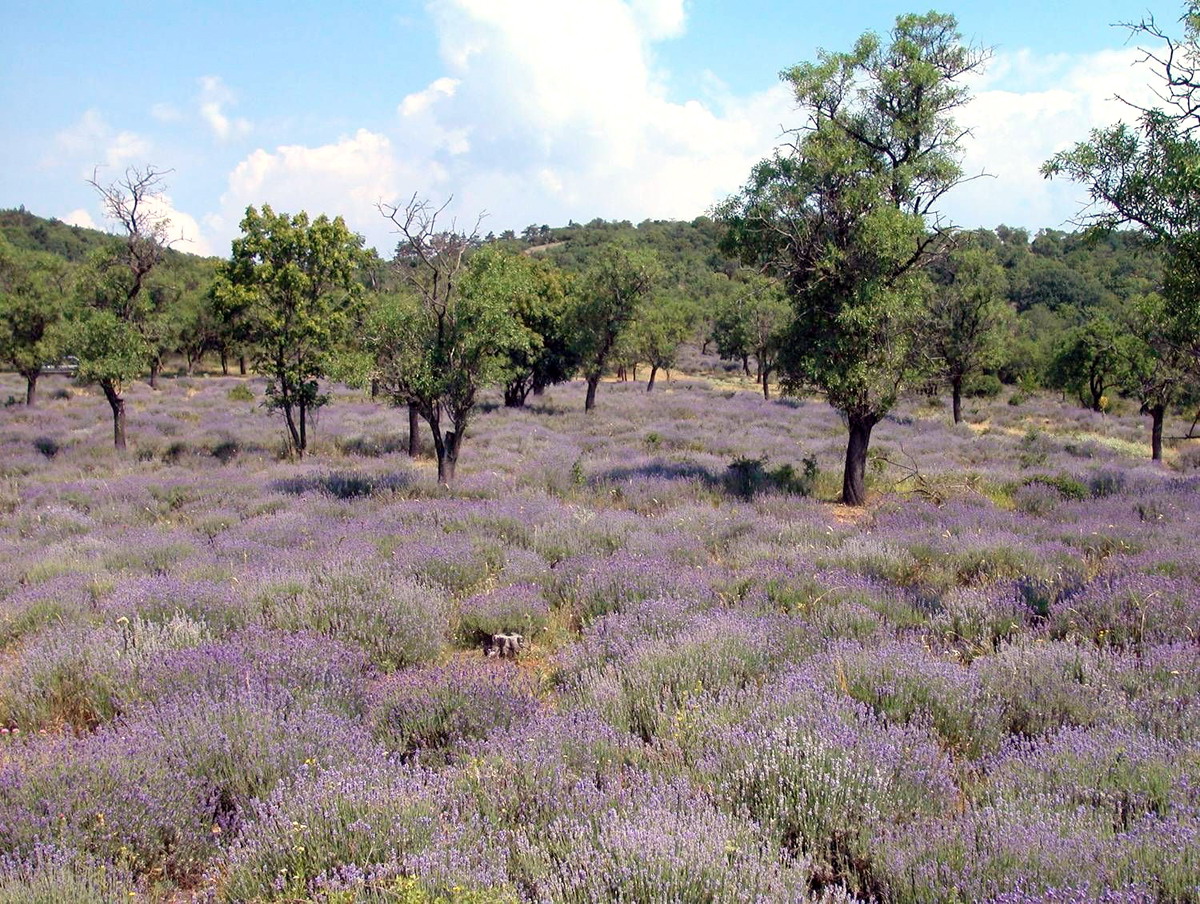
Old, abandoned lavender plantation in Tihany
Amount and distribution of precipitation
Precipitation is one of the most important climatic elements of agricultural production, but its distribution is very variable both in space and in time. Water is indispensable in plants’ life, although there are big differences between their needs. Angelica archangelica, Ocimum basilicum, Digitalis lanata, Echinacea purpurea, Humulus lupulus, Calendula officinalis, Levisticum officinale, Valeriana officinalis, Cucurbita pepo var. styriaca, Majorana hortensis, Mentha x piperita, etc. are water-demanding species, while Cnicus benedictus, Hyssopus officinalis, Thymus vulgaris, Lavandula angustifolia, Salvia sclarea, Verbascum phlomoides, Chrisanthemum cinerariaefolium, Plantago lanceolata, etc. are drought-tolerant plants with lower water-demand.
The rainiest area in Hungary is the Hungarian part of the Alps (in the western part of the country), where the annual amount of precipitation is more than 800 mm. And the least rain falls in the central part of the Great Hungarian Plain (less than 500 mm/year). In Hungary otherwise the annual precipitation can’t satisfy the plants’ needs in general.
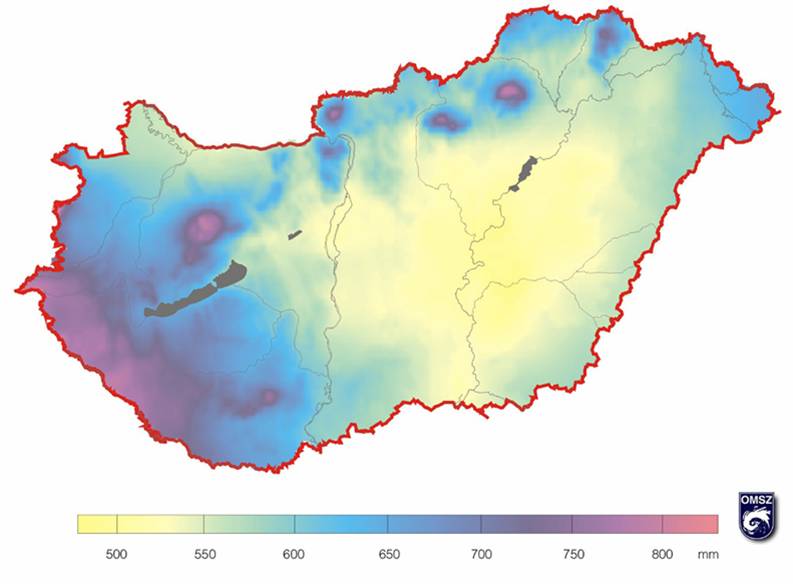
The annual amount of precipitation in Hungary
When we evaluate a growing site in terms of precipitation, we should allow for further aspects too, such as: precipitation during the vegetation period (which is usually 55-65% of the annual amount), rainfall intensity (mm/minute or mm/hour), number of rainy days, frequency of hail, frequency of precipitation-free periods, number of snowy days (it’s very changeable: in the Great Plain 30-35 days, while in the North Hungarian Mountains 100 days), the first and last day of snowing, etc.
Thus during growing site selection precipitation conditions of the territory should be considered too. Although this environmental factor can be slightly modified by agrotechnical methods (e.g. irrigation), they can be applied only in very reasonable cases and in relatively small areas because of their high cost. If we have to supply the missing amount of water with irrigation, it’s important to have irrigation facilities and irrigation water in the selected area.
Prevailing wind direction, wind speed, frequency of gusts
Wind is a natural phenomenon, but too much of it can damage the soil (deflation) and the vegetation too. Permanent strong winds can injure the foliage of plants, and the sand carried by wind can depose on the leaves of plants, clogging stomata. Wind also enhances the evaporation rate, furthermore dries the top layer of the soil. In spring it may inhibit the development of young, delicate plantlets and at flowering it can hinder the activity of pollinating insects. Moreover, wind can carry away the small seeds from the loose, dry soil after sowing. Naturally it has beneficial effects too, such as wind can offset the negative weather conditions; in spring March winds dry the too wet soil which is unsuitable for cultivation yet; it may facilitate the pollination and fertilization; as well as it can enrich the fertile layer of the soil with carried fine dust and loess. In Hungary the most frequent wind direction is the north-west.
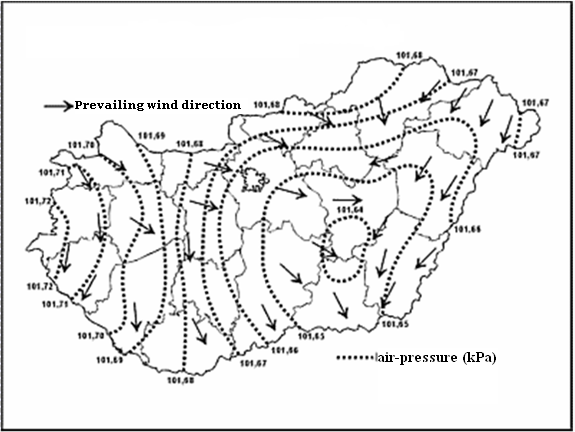
Wind map of Hungary
Taller-growing species (e.g. Malva sylvestris subsp. mauritiana, Silybum marianum, Verbascum phlomoides) usually require wind-protected areas, just like plants which scatter their seeds easily. In this case windy weather during ripening may cause considerable loss. In a windy growing site we can defend against wind with planting hedgerows or forest belts or with setting-up fences and wind break meshes around the territory. On the other hand, we can utilize the advantageous effects of wind, for example in plant protection. If we produce rows parallel with the prevailing wind direction in the course of marjoram sowing, wind will stop the warm, humid microclimate within the population. This way the probability of alternaria infections can be reduced.
Soil conditions
Soil conditions, such as type and structure of the soil, its pH, nutrient and lime content, the thickness and homogeneity of fertile layer, the level and fluctuation of ground-water, the soil’s water-holding capacity and water permeability, the soil’s contamination by pests and pathogens, etc. are also very important aspects during growing site selection. Plants should be cultivated in a kind of soil which can satisfy their biological needs completely. And although some soil properties (e.g. structure of the soil, pH, and nutrient content) can be improved significantly by agrotechnical methods, others can hardly be modified or not at all (e.g. thickness of fertile layer).
The most important soil types (in Hungary):
-
brown forest soil: it is found in the mountains and hilly areas under cool and wet climate. It has many types, but each of them is brown coloured, has calcium deficiency and high clay content. Generally more difficult to cultivate them, because the fertile layer is thin and the territory is often sloping, stony.
-
chernozem soil: it is formed on loessy lowland areas under drier climate. It is a good-quality soil type, which can be characterized by thick fertile layer. It is medium heavy and rich in nutrients.
-
sandy soil: it has loose structure; therefore it is prone to deflation. Sandy soils’ water permeability is good, but their water-holding capacity is weak. The lower organic material content is typical of this soil type. However, its advantage is that it can warm up easily and animal pests can live in it only with difficulties.
-
saline soil: it contains an excess of water-soluble salts, especially sodium. Salts are found partly dissolved in the soil solution, partly bound on the surface of soil colloids or as crystalline salts. Saline soils are very heavy, their water receiving capacity and water permeability are very weak but their water-holding and nutrient supply capacity are very good. These are suitable for only a few plant species’ cultivation (e.g. chamomile).
-
humic gley soil: the periodically too much wet played a significant role in their formation. This kind of soils are very heavy and clayey, it is very difficult to cultivate them. Their humic substances are grey or black coloured and sticky. Nutrients, especially phosphorus and nitrogen are bound strongly in them. Their water receiving capacity and water permeability is weak, but their water-holding capacity is very good.
At growing site selection the pH of soil should be also considered, because this is a kind of feature, which can’t be influenced significantly in large areas by agrotechnical methods. Many plant species are undemanding in terms of soil’s pH (e.g. Angelica archangelica, Mentha x piperita, Achillea collina, Sinapis alba, Anethum graveolens, Humulus lupulus, Calendula officinalis, Levisticum officinale, Carthamus tinctorius, Oenothera erythrosepala), but there are demanding species too. Vaccinium myrtillus, Castanea sativa, Arnica montana can survive only in strongly acid soils, while Melissa officinalis, Hippophae rhamnoides, Hyssopus officinalis, Matricaria recutita, Echinacea purpurea, Lavandula angustifolia, Valeriana officinalis, Althaea officinalis, Verbascum phlomoides, etc. are fond of alkaline soils.
The nutrient content and nutrient supply capacity of soil are also important characteristics, but these can be modified significantly by natural (e.g. green manuring, organic fertilization) or artificial (application of chemical fertilizers) methods. Nutrient-demanding species: e.g. Angelica archangelica, Hyoscyamus niger, Mentha x piperita, Levisticum officinale, Leuzea carthamoides, Cucurbita pepo var. styriaca, Ruta graveolens. Low demanding ones: Cnicus benedictus, Achillea collina, Sinapis alba, Trigonella foenum-graecum, Hippophae rhamnoides, Hyssopus officinalis, Matricaria recutita, Oenothera erythrosepala, Silybum marianum, Verbascum phlomoides, Chrysanthemum cinerariaefolium, etc.
The soil’s contamination by pests or pathogens should also be examined before planting, especially if we would like to cultivate perennial plant species. For example peppermint is very sensitive to the injury of wireworms (Limonus spp.), root-knot nematode (Meloidogyne hapla), crane-fly ( Tipula spp.) or cutworm (Agrotis spp.), which chew the roots and rhizomes. If the selected area is infested with these pests, either serious soil fumigation has to be made or other growing site should be chosen.
The natural vegetation of the area, plants of surrounding places
It is important to know the original flora of our growing site, because later the natural vegetation will appear from time to time disturbing the growing cultures. Plants of surroundings (e.g. forest or forest belt, field, meadow, pasture) can also influence the cultivated stands affecting their living circumstances. Positive effects of surrounding vegetation: these can moderate the wind’s speed and protect the soil; reduce the rate of evaporation and increase the atmospheric and soil moisture content; these are natural territory delimiters and living spaces for pollinating insects. But besides these we should calculate with some negative effects too, such as: surrounding plants can deprive nutrients and water, can negatively affect the microclimate and may shade, these can facilitate the multiplication of pests and pathogens and their weeds can cause problems too.
Proximity of high-traffic roads
Cultivation on territories along high-traffic roads should be avoided in case of medicinal plants (too), because the risk of heavy metal pollution is outstanding there, which impairs the quality of produced product or even makes it unsalable. Furthermore, the proximity of high-traffic roads disadvantageously influences the insect pollination and because of winter road salting the soil’s salt content may increase, which later inhibits the development of cultivated plants.
Economic factors
Economic factors also influence the requirement of a good cultivation location. The ecological conditions can be good for the crops, but when the labour force is expensive, and the processing factory or the market is far away, the transportation costs run up and they can ruin the whole enterprise. The following economical factors should be considered to make a good decision:
Manpower situation
Significant amount of cultivated medicinal plants (e.g. marigold, mallow species, mullein, thyme, marjoram, tarragon) can be cultivated economically only in small,- or middle scale farms (0.1-10 ha) because some of the technologies can not be mechanize, it is labour-intensive. In the case of these species, the sufficient, available and cheap labour force is an important economical factor. This is not so important at large scale farming because everything is mechanized (e.g. anise, white mustard, carraway, poppy, milk thistle).
Distance from market and processing capacity, destinations, road conditions
Other prior question in location selection is the distance from processing factory or market. It is not negligible how many kilometres should the raw material or processed product be transported. If the harvested plant will be sold in fresh condition (e.g. for essential/volatile oil distillation) it is even more important. During the long transportation time, plant parts can be damp and their quality decreases rapidly which will push down the selling price or even the possibility to sell. Poor road conditions can decrease the travelling speed and increase the travelling time.
Storage capacity, available buildings, machine stock
It should also be assessed whether there are empty buildings or other storage places nearby or other possibilities to rent buildings, machinery and drying equipment which will be needed for the post harvest technologies. Thus the enterprise could start with less capital input.
Cultivation traditions, territorial concentration, concurrency
The starting of a new enterprise may be supported by the traditional knowledge of the cultivated plants if it has traditions in the area. Thus up-to-date technologies, plant varieties, cultivation experience and developed processing possibility are already present. On the other hand, if many farmers are cultivating the same crop it can lead to a competition between them. To prevent this competition and in order to increase economical and efficient production, different cooperations had formed. One of these is the Producer Organisations (PO) in Hungarian Termelői Értékesítő Szövetkezet (TÉSz). This is a new type of organisation where a community of producers and salesman form a non-profit organization to coordinate the production and sale. Their aims are to reduce the costs and improve the competitiveness by selling the individually produced crop together on the market. Nowadays this type of organisation can be found mostly in fruit, flower (sureplants.nl, floraholland.com) and vegetable branches, but in Western Europe (the Netherlands, Denmark, Germany) medicinal and aromatical plant producers (MAP) start to established their own. Unfortunately in Eastern Europe, due to mistrust of one another, these processes are only beginning.
Support system, territorial preference
In the choice of location of production it should also be taken into account that the region may have some kind of state or EU funding. The most underprivileged micro-regions get more options to apply funds to aid job-creating businesses or other financial support. These parts of Hungary are Southern Transdanubia, Northern Hungary and the Northern Great Plains where the unemployment ratio is the highest.
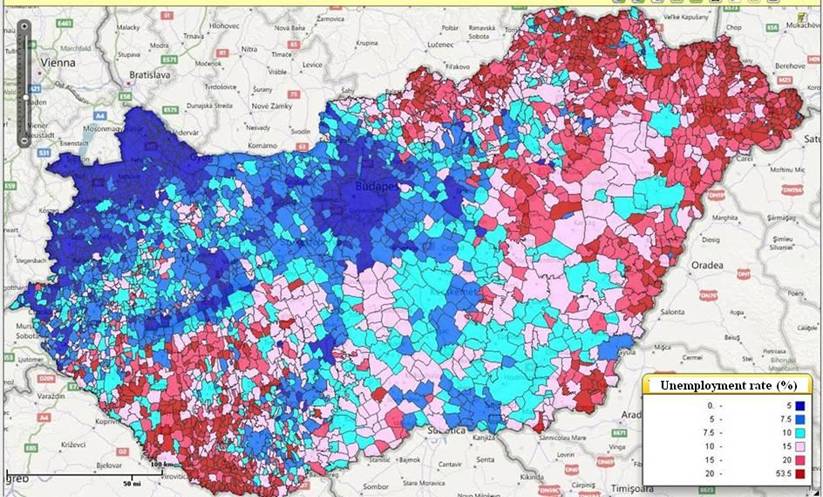
Unemployment rate in Hungary (May, 2011)
The role of crop rotation and PRE-crop
The definition of crop rotation and its elements
During agricultural production instead of monoculture cultivation (which depletes the nutrients and water resources of the soil one-sidedly and in the long run it impoverishes the soil making the soil less fertile at the end) it is worth applying crop rotation, alternation of crops because this way not only the yield can be increased but the quality as well, accordingly an environmentally friendly and sustainable agricultural production can be maintained. The more unfavourable the environmental conditions are, the more important it is to apply crop rotation.
Crop rotation means the efficient utilization system of the habitat by cultivated plant species; or rather it is a methodical plant-growing system, in which species follow each other in a pre-planned order both in space and time. Species showing reduced yield-capacity after having been cultivated after themselves, can be cultivated successfully only in crop rotation. When planning crop rotation there are four elements to be ascertained:
-Plant combination: that is to say, what kind of plant species are going to be cultivated at the (to some extent) uniform area of a given farm. While considering the range of species, the aim must be to involve more and more species into crop rotation in order to make the diversity-level higher. Of course this must be adjusted to the market demands.
-The ratio of species in crop rotation: Means defining the area-percentage of each species in their sector taken from the total area. In this case there are many factors to be taken into account, primarily the economic situation of the farm (profitableness, possibility of sales and of establishing power agriculture and manual labour supply etc.).
-Order of species: how the species follow each other (consecutively) on a given sector in the course of time. By configuring the order of plant species, the green crop effect of the different species is determinant. During cultivation, each species is a green crop of the subsequent species (coming next in the crop rotation).
-Circulation (rotation): Means defining a time period, which tells us how much time has to pass until the species in question can be replanted to the same sector. The time interval, during which all of the species of the crop rotation progress the whole area and at the end return their initiative sector, is called the crop rotation interval.
Classification and types of crop rotations
Crop rotations, in which the composition and ratio of the cultivated species are particularly determined, the order of the species is worked out both in space and time, are called classical or coherent crop rotation (Figure 3.6.). Crop rotations, in which we can not name concrete species but single out plant groups or families which possess the same agricultural conditions (for example: vexillars, intertilled crops demanding organic manure, industrial crops, Apiaceae species, etc.), are called frame crop rotation.
Figure 3.6. Classical or coherent crop rotation ( gyogy3.8.jpg ) animáció, a minta power pointban megszerkesztve
Crop rotations can be grouped according to the type of sectors. The sector (of a crop rotation) is the basic unit of the crop rotation area, on which a given portion of the species is cultivated. On the basis of the latter mentioned fact we can differentiate between simple-sectored crop rotations (where the sector of crop rotation is occupied by one species) and divided-sectored crop rotations (where at least one sector is planted with two or more species). Sectors within the crop rotation can be of different area.
Crop rotations can be divided on the basis of the crop rotation interval as well. There are short (lasting to 2-3 years), middle-long (lasting to 4-10 years) and long (lasting more than 10 years) crop rotation intervals. In the short crop rotation the species reach their original sector soon, so the isolation against pathogens can not be developed in due time. While establishing long crop rotations the organizational processes split into smaller acts and then transparency becomes deteriorated. Therefore in general, farms are aimed at organizing middle-long crop rotations.
If we are interested in involving perennial species into cultivation and crop rotation, which phenomenon is very frequent at cultivation of medicinal plants, the sector occupied by the perennial plant (e.g. lavender) is left out from the rotation during its cultivation and hence its sector is called sector out of rotation. After perennial plants become superannuated, they are grubbed out and then their sector reconnects into the rotation area. Instead the area of the newly planted perennial plant becomes the sector out of rotation. On the basis of the latter mentioned facts, we can differentiate between crop rotations with and without out of rotation sectors.
Furthermore crop rotations can be irrigated or non-irrigated ones, agronomic (industrial, above 30 ha) or intertilled/horticultural scaled (2-30 ha). Crop rotations consisting of only medicinal plants are very rare; the medicinal plants are planted together with spiciferous plants at agronomic-scaled cultivations and primarily with vegetables at smaller farms.
The objectives of crop rotation and the aspects of its planning
Maintenance and development of soil fertility
The amount of organic matter given to the soil by cultivated plants is very varying. Some species leave less root and stubble behind, while others leave more amount of organic matter, which is replaced into the soil by tillage. There are differences according to the speed of root-decay of the species. Some species possess roots which decay faster; while others have roots which rot more slowly (the decaying root ensures the distribution of humus the most perfectly in the soil). It has been observed that the amount of the organic matter left behind in the soil is in positive correlation with the amount of crops gathered. By means of changing of species rooting to different soil levels, the water management of the soil can also be improved.
When planning crop rotation one must pay attention to applying species possessing different root-types, considering the amount, the type, the soil-netting ability of the root and even how deep it can get into the soil. After species possessing slow-decaying roots it is suggested to plant species sown in spring. Species which root deeply in soil are: liquorice, hyssop, valerian, medicinal pumpkin, Malvaceae spp., sage etc.; species which root shallow in the soil are: tagetes, chamomile, marjoram and mint species.
The nutrition demand and the ability of nutrient intake of the different species are varying as well. Some species are able to intake huge amount of nutrients from the soil (e.g. angelica, peppermint, lemon balm, hop, lovage, medicinal pumpkin, sage and tarragon) and there are the vexillars which can countervail the nutrient deficiency of the soil. By applying vexillars the soil nitrogen-content can be regenerated, hence less ameliorator is needed during cultivation. That is why it is advisable to plant species possessing high nitrogen demand after vexillars in the crop rotation. Furthermore after species of soil-depleting type, the sowing of species with high nutrient demand should be avoided, and it is worth cultivating species with increased organic matter consumption (intertilled crops) after plants which contributed to the organic matter of the soil (perennials).
After species requiring farm-manure and being cultivated usually at the beginning of the crop rotation, the remainder plants follow according to their demand for farm-manure. Species requiring farm-manure are: lemon balm, purple coneflower, rue, medicinal pumpkin, tarragon, rosemary; and species non-demanding for farm-manure are: woundwort, tagetes, ox-tongue, white mustard, marigold, poppy etc.
Maintenance and improvement of soil water management
The effect of plant species on the soil water management is important primarily in non-irrigated cultivations, while this effect is less determining under terms of irrigation. When planning the crop rotation we must make sure that after a water demanding species, a xerotherm species follows. Species of high water demand type are: angelica, common basil, peppermint, purple coneflower, lovage, valerian, marjoram and species of low water demand type are: Satureja, absinth, common thyme, lavender, sage, hairy mullein, rosemary, etc.
Maintenance and development of soil construction
If the cultivated species possesses wide leaves, their huge amount of green yield provides shade for the soil, and it can moderate the unfavourable effects of the weather on the soil. It also lowers the impact power of raindrops and the soil drying effect of the sun and wind. It can hinder nutrients from being washed quickly into the subsoil and it helps preserving water content of the soil. Furthermore it is beneficial for the looseness and aeration of the soil and for the biological activity of the soil. Green crops overshadowing the soil create good conditions after being gathered for the tilling and they benefit the initial growth of the following plant.
Good shading plants are: densely sown species cultivated in single-crop system (for example: Apiaceae spp., lady’s thistle, mustard species) and species possessing huge leaves (for example: ox-tongue, hairy mullein). Species with less shading ability are: intertilled crops (for example: basil, common thyme, marjoram) where the spacings are free. When planning the crop rotation it is worth alternating good shadowing species with intertilled species.
Protection against erosion and deflation
40% of the Hungarian plough-lands can be found on slopes, where one must calculate upon regular damages caused by erosion. Appropriately established crop rotations can do a lot for the protection of the most valuable upper layer of the soil, full of nutrients. The best form of protection is the coverage of the soil by plants. It is important that plants should protect the soil at critical period of time as well (for example: in the rainy days of autumn, winter and early spring). Hence soil coverage must be ensured before sowing plants in spring at areas exposed to erosion.
The protection effect of the vegetation is appropriate if the stand density is balanced, the rate of shadowing is good and the vegetation period is long enough. Densely sown plants ensure higher protection level than intertilled crops, that is why it is forbidden to cultivate intertilled crops on slopes having more than 12% inclination.
At areas exposed to erosion we may involve a new accession before the sowing of the following plant in crop rotation, on the stubble of plants gathered in summer (to obtain green manure), in order to increase the soil preventing effect of the cultivation. For this purpose such plants are suitable which develop strong roots, grow fast and have cheap sowing-seed (for example: fiddleneck, white mustard, fodder radish, summer rape).
Protection against replant problem
The sensitivity of plants concerning their cultivation after themselves is called soil sickness or replant problem in practice. There are many reasons for the existence of replant problem, for example the accumulation of toxic compounds in the soil, microbiological damage, deficiency of microelements, destruction of soil construction, nematode infection in the soil etc. Its effect is a remarkable yield-reduction.
With the help of crop rotation the replant problem can be avoided, if we pay attention at the planning stage to plant a given species, which can not be cultivated after itself, to the same sector only after certain years. Otherwise the growing of the plant is endangered. The necessary waiting time has been calculated for several medicinal plants, it is 2-3 years for Satureja spp., 4 years for common thyme and caraway, 4-6 years for flax, 3-5 years for poppy and 2-3 years for carthamus etc. If literature doesn’t supply us with data relating to waiting time, it is advisable to calculate with 3-4 years. Chamomile can be cultivated in monoculture as well.
Protection against weeds
Crop rotation is the cheapest and one of the most effective ways of cleaning weeds. With help of crop rotation the frequency of clearings and the amount of herbicides used can be significantly reduced. Its effect is based on the fact that there are two types of cultivated plants: „anti-weed” plants and „weed-growing” plants. The characteristic feature of a good weed-suppressing plant is, that under their cultivation we carry out intensive and careful clearing (for example: intertilled crops), and these plants hinder the growth of weeds by their fast initial growing rate and by their huge amount of green mass (for example: ox-tongue, Jerusalem artichoke, lady’s thistle). Plants of weed-growing type are not able to act this way, they even have low initial growing rate and poor foliage hence weeds can grow fast between them and can easily propagate. Weed-growing species are for example: woundwort, fox-glove, flax, marigold and marjoram. When planning crop rotation one must be pay attention to the alternation of weed-growing and weed-suppressing plants. Slowly growing species (coriander, fox-glove, marjoram) must follow weed-suppressing plants.
The clearing can be supported by the appropriate timing of the different cultivation time of plants and of the interval between the two consecutive plants. If we plant chamomile as green crop, and after it comes a plant sown in spring, the summer weeds can be cleaned up to a great extent during stubble-ploughing and nursing. If valerian was cultivated on the area the previous year (which is gathered at the end of October), and after it we sow plants in late spring (for example: medicinal pumpkin), then we have the opportunity to clean up weeds piercing out in early spring.
Preventive protection against pathogens and pests
When compiling the plant order it is an important principle that host-plants of the same pests and pathogens must approach each other neither in time nor in space (for example members of Apiaceae, Solanaceae, Brassicaceae families, or after the perennial vexillars the poppy, as they have common pathogens: Fusarium spp.). Plants can be planted after themselves or after other host-plants until pathogens and pests lose their vitality and reproductivity (isolation in time). While placing the plants we must pay attention that host-plants of given pests and pathogens mustn’t be planted even on the neighbouring sector in following years (spatial isolation).
The transmission of pathogens and diseases from one plant to another can be moderated if host-plants are alternated with non-host-plants, this way the food-chain of pests and pathogens is cut.
The importance of timing in soil preparations
When establishing crop rotation it is important to have enough time for soil-preparation after the green crop had been gathered and before the following plant is sown. Hence plants sown in autumn are planned to be planted after species gathered earlier. If plants gathered early follow plants sown in spring, the long period between the two accessions can be used for cultivation of green manures (cover crops), primarily under habitat conditions of higher precipitation levels.
By observing the mentioned principles of plant alternation, not only a balanced and higher yield can be obtained but significant cost-saving can be counted on, as the beneficial effects of plant alternation can be substituted only by expensive agrotechnical and nursing operations. Along with the economical and effective cultivation, the unnecessary pollution of the environment is hindered as well, so we can establish an environmentally friendly, sustainable farming (production).
Applied tillage methods and their machines in medicinal plant cultivation
Aims of soil tillage
Tillage is the preparation of the soil by mechanical agitation, to create such a physical condition which can satisfy the optimal needs of cultivated plants.
Main tasks:
- Improvement of the air and water management of the soil (e.g. aeration, water conservation)
- Regulate the temperature and nutrient management of the soil (e.g. the excessively wet, clogged soil warm up more slowly, and the degradation of organic fertilizers is obstructed)
- Increase the amount of available nutrients (e.g. manure, green manure, fertilizer allocation to the soil, and stubble cultivation)
- Soil overturning: change the rundown topsoil for the nutrient rich lower layer
- To create a friable soil texture
- To accelerate the residual degradation and enhance the biological activity of micro-organisms
- Plant protection (e.g. by burying the weeds and the soil pests get unfold)
- To shape the soil surface (make it flat, or ridge-shaped: e.g. in case of Horse-radish or Saffron
- Protection against erosion (e.g. use of hard duty rollers on loose, sandy soil for compressing)
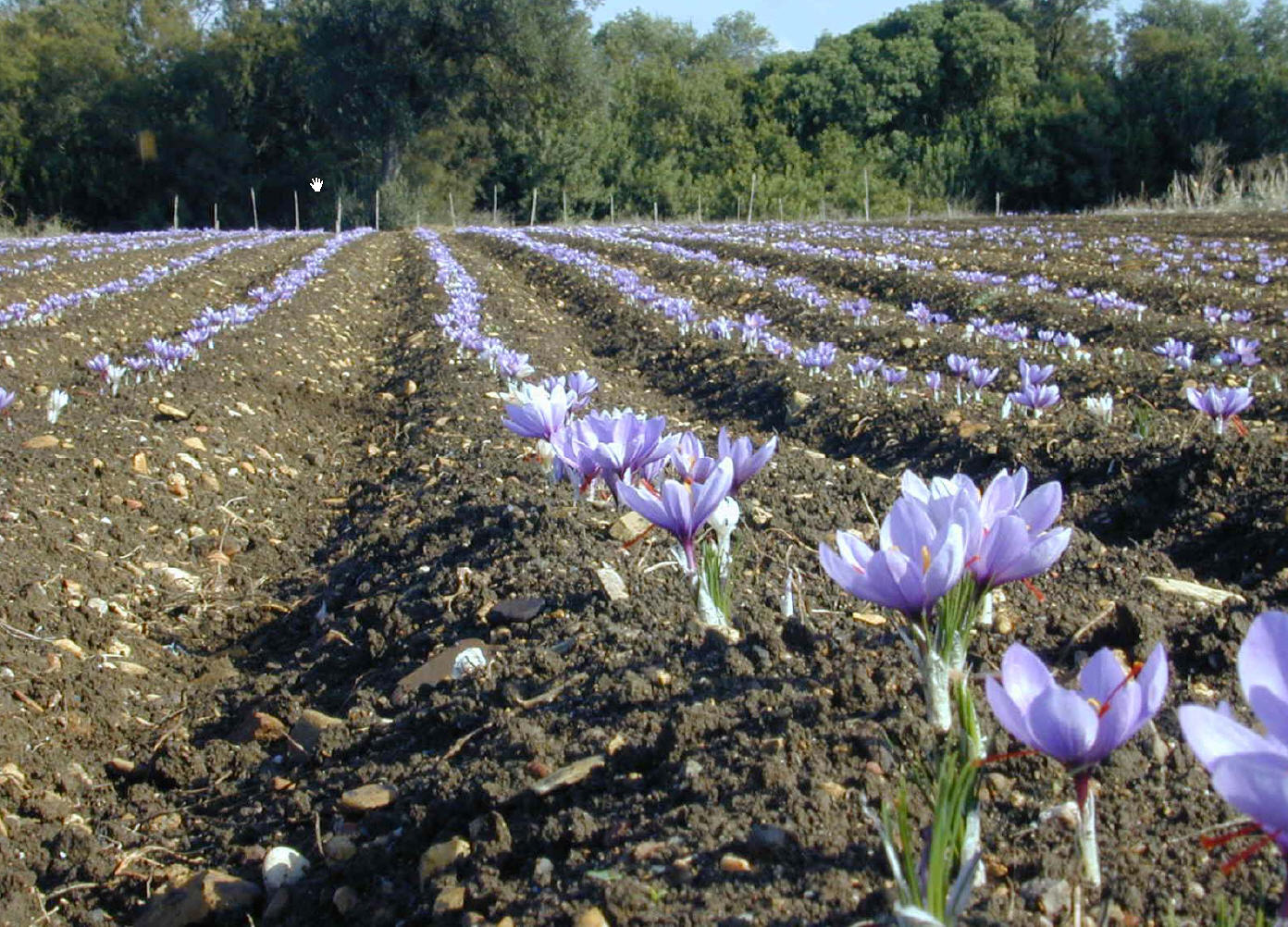
Saffron cultivation in Greece
Properly selected and well-timed soil tillage techniques can be a good beginning of a successful cultivation. Excessive tillage, however, can be just as harmful as the too rarely made one. It can cause nutrient and water loss, accelerate the degradation of organic matter, increase the risk of nutrient leaching and the soil structure can deteriorate, which could impair biological processes that are taking place in the soil.
Soil tillage technologies
Ploughing
It is one of the most commonly used methods of soil cultivation in Hungary. The tillage tool for this technology is the plough (BrE) or plow (AmE). Depending on its type, two ploughing modes can be distinguished. First is the single-sided ploughing which is made by the one-way plough. It always turns the furrow slices in the same direction, and because of this, ridges and furrows are formed in the field (the other aim is to reduce the numbers of these). The other one is the reversible ploughing which is made by the turnwrest reversible plough.The plough lines can be turned over so the furrow slices fall on the different side but in the same direction.
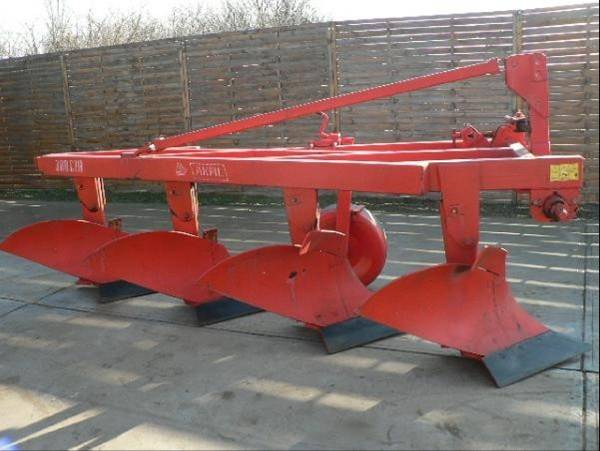
Single-sided ploughing
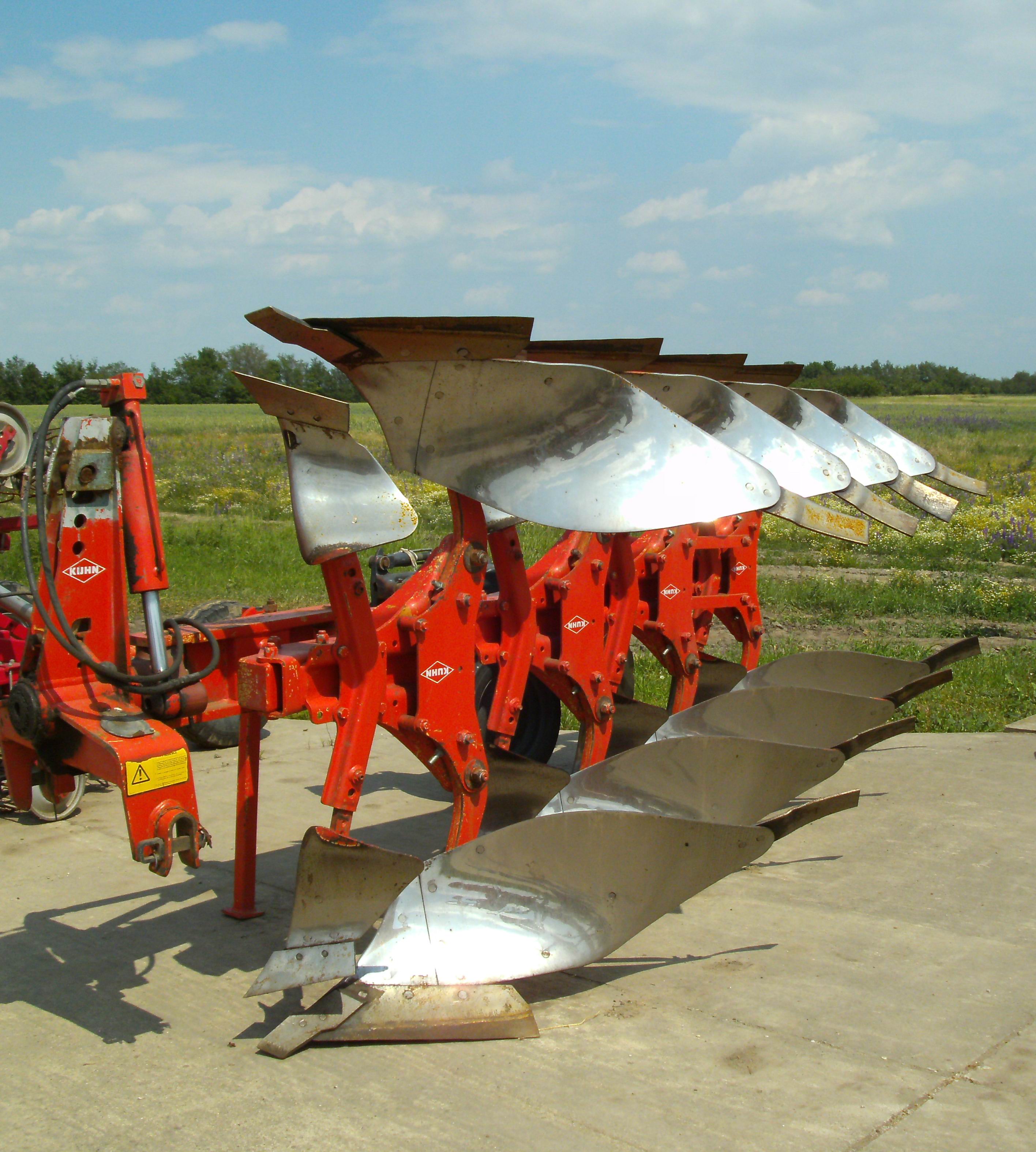
Turnwrest ploughing
For the determination of the ploughing depth, several factors must be considered, like the crop’s needs, the subsoil quality (highly stony or poor quality subsoil should not be turned over to the surface) and the physical condition of the soil. There are 5 subdivision of the ploughing depth. The shallow ploughing: when the working depth is 12-15 cm (rarely used nowadays). The middle deep ploughing with 16-20 cm depth, the deep ploughing with 21-30 cm and the rose-bit ploughing with 30-40 cm depth. When it is more than 40 cm it is called very deep ploughing (rarely used, e.g. in orchards before plantation). It is important to change the depth of ploughing from year to year, to avoid the emergence of hardpans (dense layer of soil that impededrainage of water and restrict the growth of plant roots), but a notched plough-share can also cause that.
The optimum time of ploughing is in the fall (autumn ploughing), because the soil is sufficiently moistly by the abundant rainfall. Such soils are easy to crash, fewer clots are formed during the plough on the surface, the tillage is also simpler and it makes the soil more capable to take in the winter rainfall. It buries the perennial weeds and allows the manure to allocate into the soil. Autumn ploughing is used for the spring planted crops (spring crops). In the case of autumn plantation, the ploughing should be carried out in the summer (summer ploughing). If the weather is dry , the risk of significant water loss is higher in the soil, and the surface will be rugged also. The ploughing can be made at spring time in some exceptional cases (e.g. the preceding crop is left for stubble till spring time to reduce the damage of wind deflation in a loose and dry soil). The plough depth of summer and spring ploughing can be maximum 16-20 cm (medium) to maintain soil moisture. As it is a drastic intervention for the soil, more than one application per year is not suggested, also in some certain cultures, it can be omitted. However, for manure allocation it is inevitable.
When considering the speed of ploughing we take into account the fact that by a slower speed the turnover of the furrow slices will be better and the ploughing depth more even, than at a faster speed.
Use of disc
After the plough, disc is the second most widely used tillage machinery. It is made with discs, which have simple or serrated-edge, it can be in one-or two layout. Concerning their weight, heavy and light type can be distinguished which work in different tillage depth. These tools are responsible for crumbling, and crushing the soil rug and crop residual. The scalloped-edged discs have an intensive crushing and shredding characteristics, thus it is used on stubble fields with a lot of plant remains. The application of disc has an important role in the weed control. They can be used to reduce annual weeds, but on the other hand they propagate – cut into pieces which rise a new plant - species with creeping rhizomes. It also has a mixing and loosening function, plus it makes the surface flat. The seed bed preparation with the discs during a dry period is not recommended, because after that the soil can dry out easily and the germination won’t be appropriate.
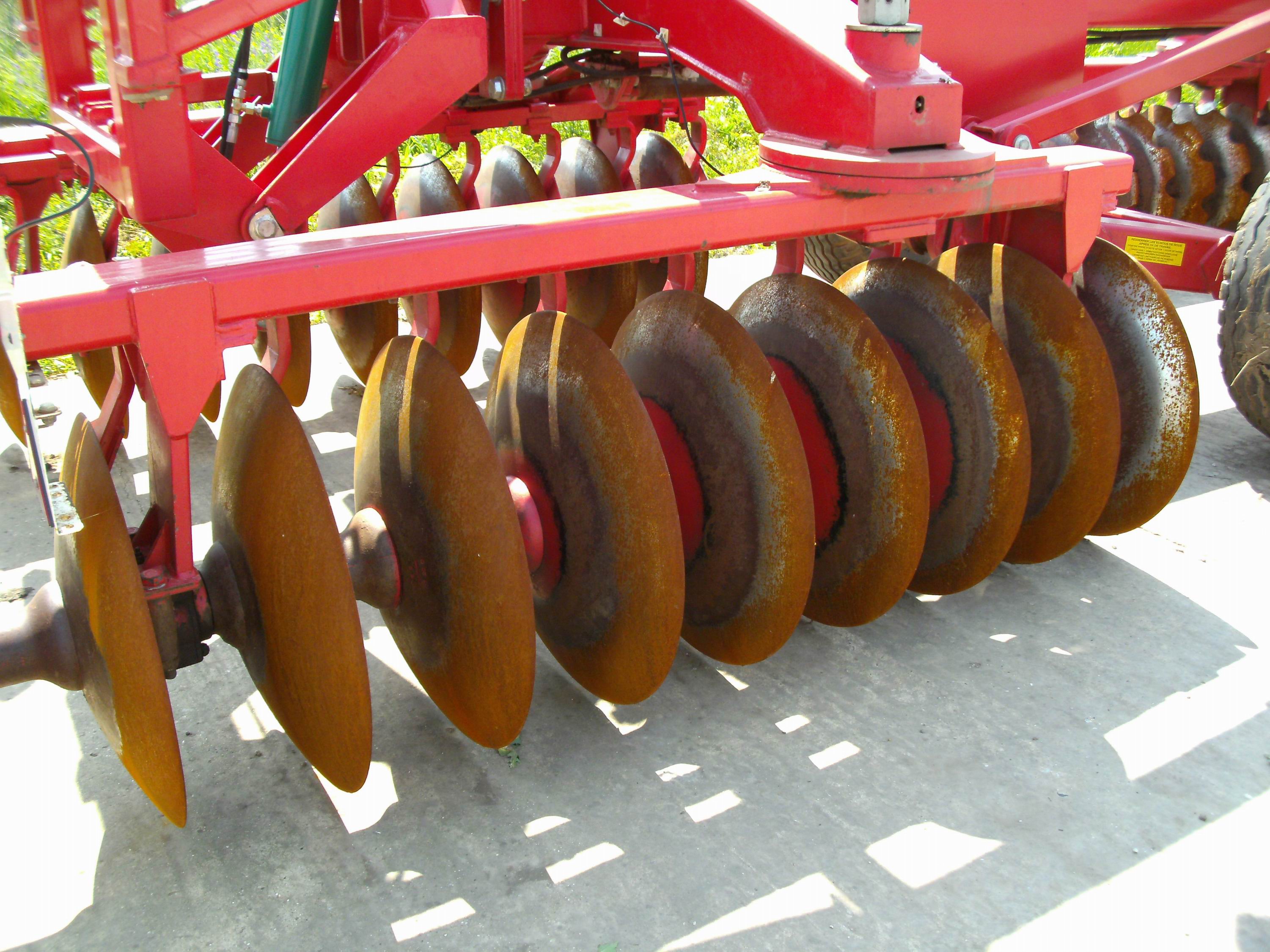
Simple edge disc
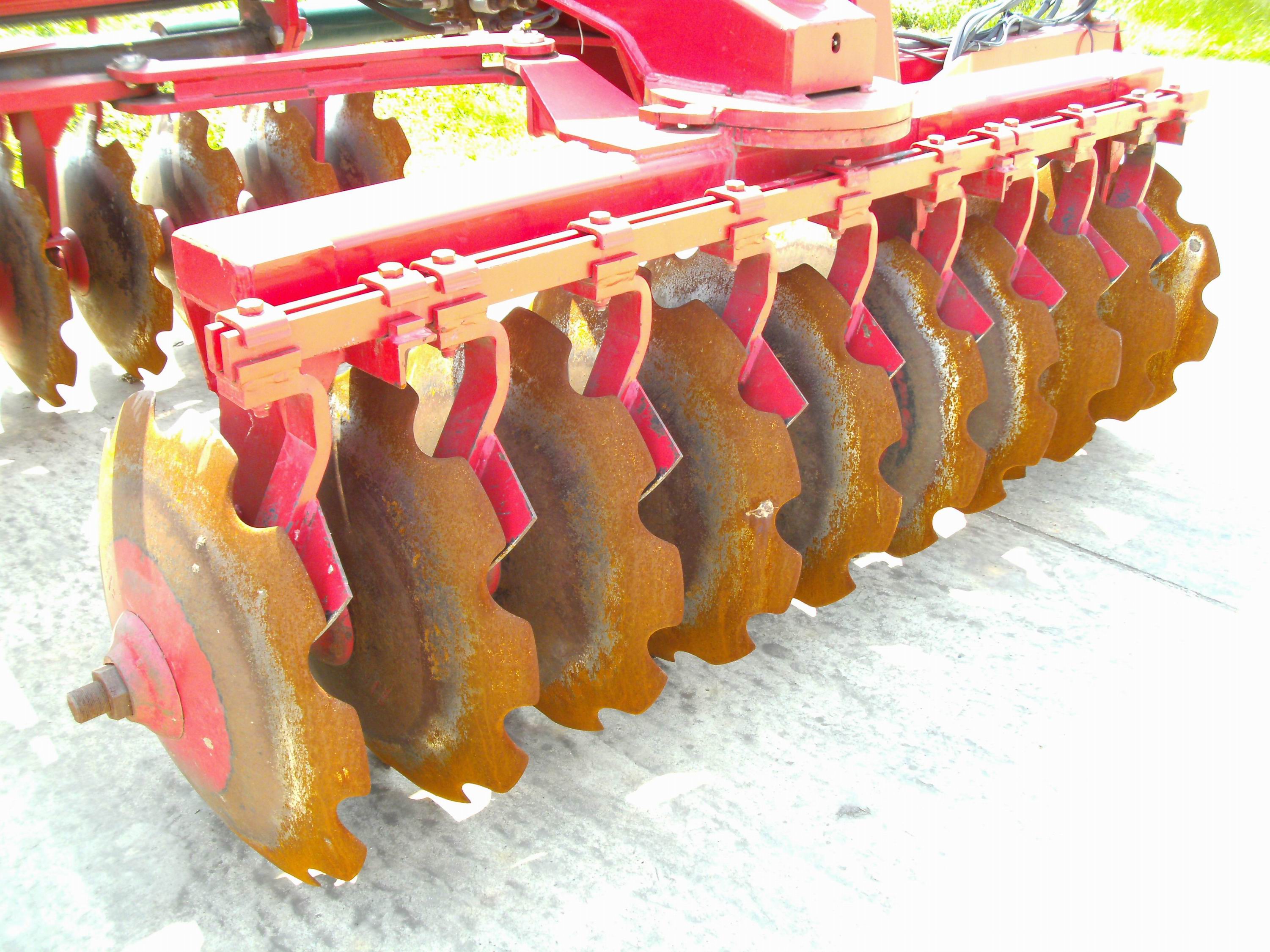
Serrated disc / Harrow disc
Other advantage of the discs is the large working widths, the high performance, and low cost requirements. It has a huge importance by stubble cultivation and in the soil preparation before sowing.
Use of disc in Soroksár VIDEO
Soil loosening
During the loosening of the soil, solid particles get farther apart from each other, thus the soil volume increases. Because of that it can absorb more moisture (the available water capacity and water permeability is improved), and the aeration ameliorate. In a loose soil, plant roots can grow stronger as they run into less barriers. Other advantage is the break of hardpan (which was caused by ploughing) and it makes deep cultivation for specifically deep-rooted plants. This method does not dry out the soil like ploughing. It has herbicide properties too (cut-off weed roots), and can be used for surface forming, but its mixing effect is minimal.
Main tools of loosening are the soil loosener and the cultivator. They are commonly grouped by the depth of soil loosening. Starting from the surface, in the maximum 15 cm deep loosening is made by cultivator, between 15 and 30 cm with the heavy cultivator, from 30 till 50 cm with the middle deep loosener and from 50 to 90 cm with the deep loosener. Loosners are used between 30 and 90 cm and the cultivators in the upper 30 cm.
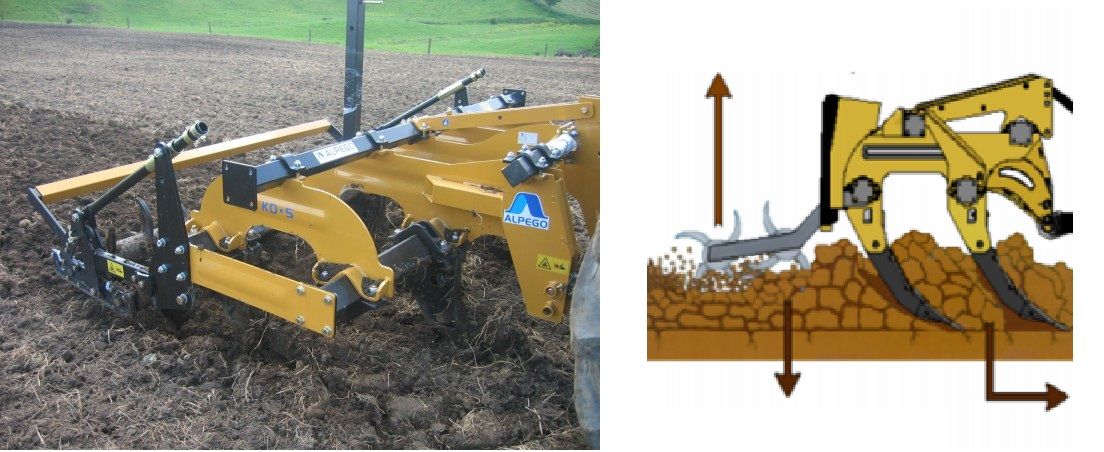
Soil loosener
The cultivators can be divided into inter-row and field type, according to their use. The inter-row cultivators have fixed arrow shaped shares, and work in the upper 5-10 cm of the soil. It is ideal for wide row space crops that need proper weeding. The field cultivators can be light or heavy duty cultivators which is also called Chisel-plough. It has chisel-shaped shares, and the tillage depth is between 8 and 20 cm. It can be used out of the growing season (eg, stubble cultivation, sowing soil preparation).
Inter-row cultivator
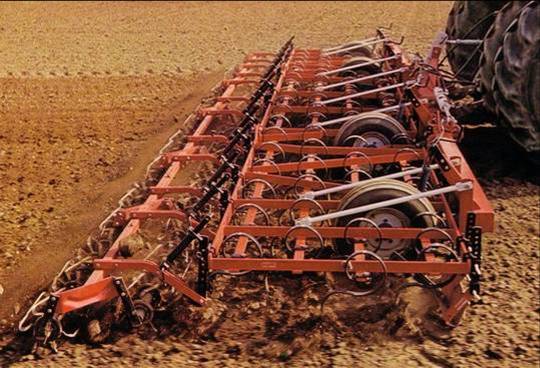
Ligth duty cultivator
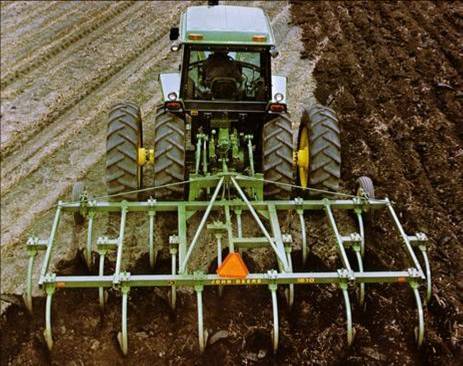
Heavy duty cultivator or chisel-plough
Rotavate
It is made by a tool called rotavator, which are equipped with rotating blades. They cut the soil, and throw the slices with a great force to the cover plate, whereby it will be fragmented. Its aim is crumbling and weed control, except for the creeping perennial weeds. Other advantage is that it mixes the organic material (e.g. green manure, organic fertilizers) better than other technologies and it leaves the soil surface without ridges and furrows behind. Its disadvantage is that it can be used only in case of narrow soil moisture condition and good humus content. This work type has a relatively high energy needs.
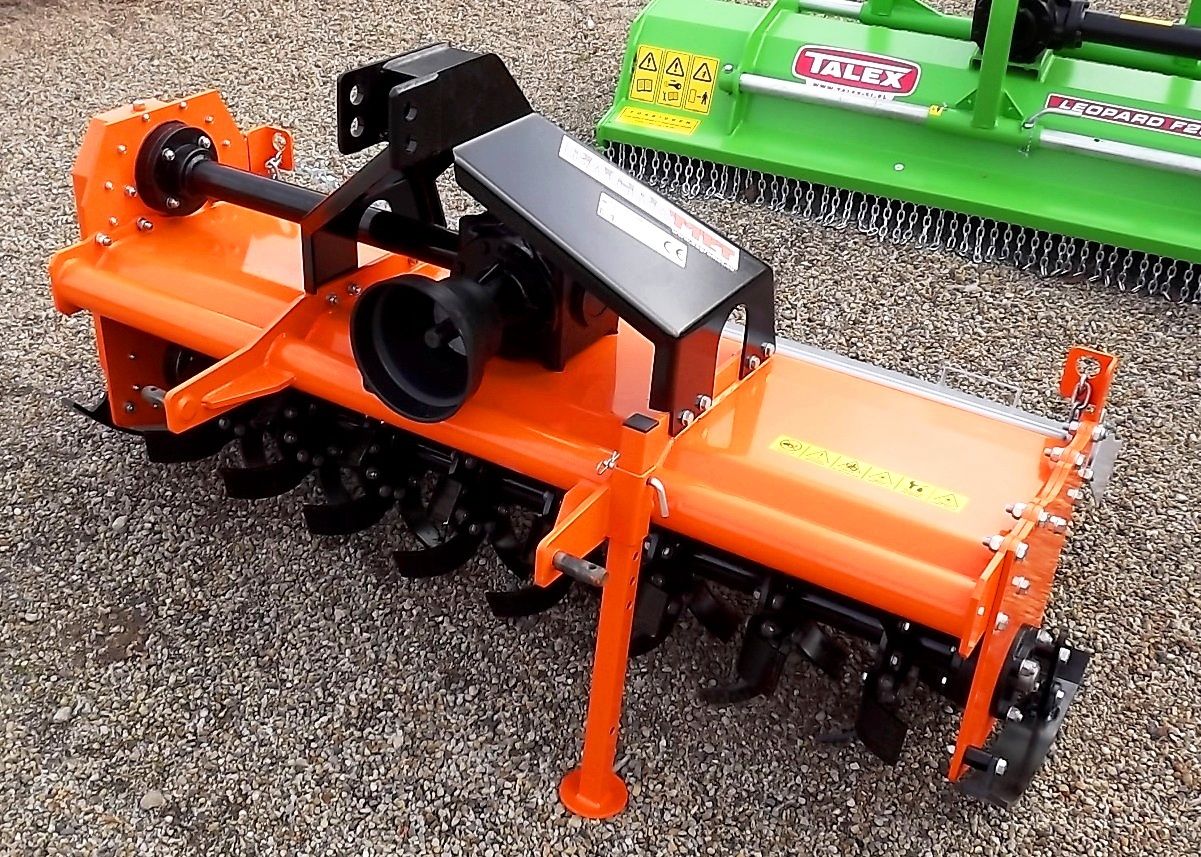
Rotavator
Harrowing
Different types of harrows are the tools for it. These can be the following, spring-tooth harrow (most common), rotary-, power harrow, or chain harrow (for a better soil aeration). All of these harrows shape the upper 3-10 cm of surface through clod breaking. After the tillage the topsoil will be friable and traversed by air. These give an insulate nature which can hold more moisture in the soil. It is applicable for sowing cultivation, stubble cultivation in meadows and pastures where chain harrows are used. The difference between the harrowing and cultivator use is tillage depth. The harrow has several but short tines.
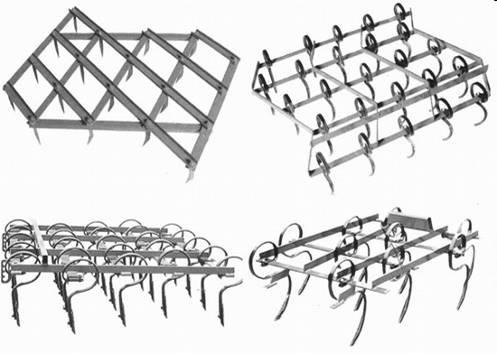
Harrow bodies
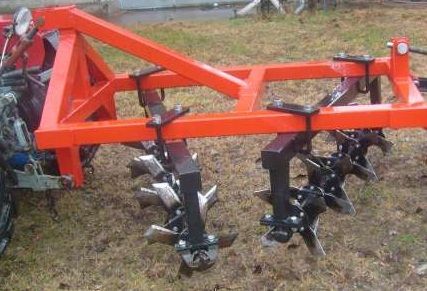
Rotary harrow
Soil smoothing
Forming the surface of the soil is very important for the tillage. Drag is used for it, which is usually a simple wooden, concrete or steel beam that is dragged by a tractor. For loose and sandy soil lath or angle drag, for rugged clayey soil iron drag can be used. It is not recommended on wet argilliferous soil, because it could grease it. It should be neglected in trampled and weed occupied soil, harrow is suggested here instead. The main aim of soil smoothing is the plough cultivating (it is fixed after the plough in an 45° angle) to crumble the rug and to flat the surface which is important for seed bed preparation. A flat surface have better water conservation, and the evaporation is smaller.
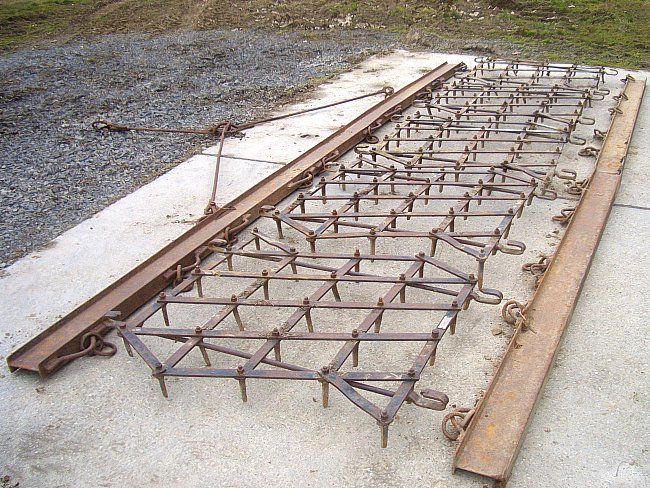
Iron drag
Rolling
Breaking up large soil is the primary aim of the use, secondary is the flattening of the land, whereby the soil particles get closer to each other thus the air and water content of the soil reduces (it is opposite of the loosening). It is appropriate to use, always after sowing whereby the flattening reduce the void fraction. Thus the soil warms up faster, conserves the water better, the organic substances degrade easier so the seed starts the germination in a much better condition.
The tool for it is the roller, which can be variable. For a less rugged soil the flat roller, for medium rugged or to work in a deeper soil level the ring rollers are used. On hard clay soil, for the big soil particles the Cambridge,- Crosskill rollers are useful, the Campbell roller is good for the deep compressing and for the fast closing after ploughing.
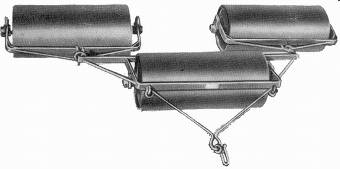
Flat roller
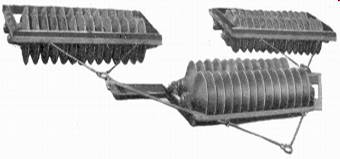
Ring roller
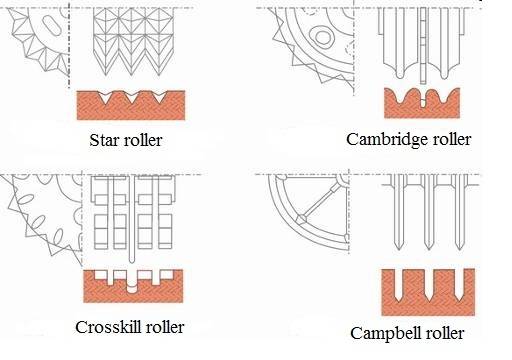
Hard duty rollers
Besides the breaking up, it makes the surface flat. In exceptional cases it can used for plant protection in winter time, where the sprouted crop are pushed back into the ground to help the root development.
Use of combinator
The most unintended effect of tillage is the compaction of the soil through the trampling. The damage is increasing each time we go to the field. The smaller the contact part of the machine with the ground the greater the pressure is on it. This side effect can be reduced by use of special, agricultural tyre with bigger surface or by decreasing the numbers of work processes in the field, that is what we use the combinatory for. Where soil loosening (cultivator + harrow) and compressing (different roller) parts are connected, thus the two processes can be made in one turn. It is ideal for seed bed preparation.
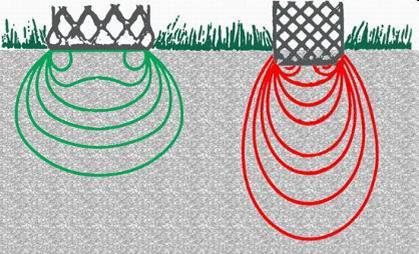
Soil compaction effect by different rubber types
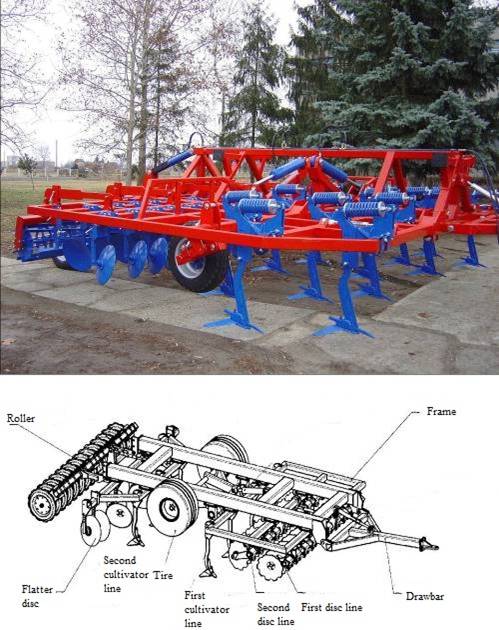
Combinator
Figure 3.26. Use of combinator, Soroksár ( gyogy3.30. avi) VIDEO
Classic order of soil tillage
Stubble ploughing
This is the first process after the harvest, which should be done as soon as possible. It is usually done by discs, sometimes with cultivator in the upper 6-10 cm of the surface. For better water conservation it has to be compressed (close the surface) with a roller in one turn.
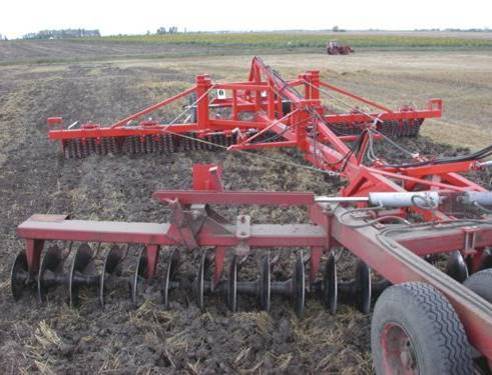
Stubble ploughing
During this phase the crop residuals are chopped, this accelerate the degradation process because of the bigger active interface. It also helps the topsoil reserve humidity. It has an important role in the weed control by helping the weed emergence which will be annihilated by primary tillage, and the loose surface has a smaller resistance impact next time so we can save costs as well.
Stubble cultivation
Stubble cultivation is the process when the stubble ploughing is repeated 3-6 weeks after the first one. It is necessary if too much time passed between the stubble ploughing and primary tillage, and the weeds start to overrun the field. Perfect tools for this are the different clump or nugget breakers (discs, cultivator, combinator, rotary-harrow). The tillage depth is 10-15 cm in a 10-45° gang angle. In the end it has to be compressed (closed) with roller.
Primary tillage
Primary tillage is a tillage technology which produces a rough surface, and has a long term effect on the soil during the growing season. It also crumbles the soil in the top sub layer. The primary tillage is often classified into two types:
1. With turning (Intensive tillage), where the main tool is the plough. It can be used for shallow-rooted crops beside good soil condition or for manure allocation.
2. Without turning (Reduced tillage, Conservation tillage) main tools are discs, cultivator, looseners. It can be used in arid climate or for a deeper tillage when the ploughing is unadvisable. If the upper (40 - 45 cm) layer of the soil is good for crop growth the loosening can be omitted (it is appropriate to fit for the root-zone depth).
Smoothing the primary tillage
It is not necessary if the primary tillage is done in autumn or spring time before sowing or plantations (the winter freeze breaks the bigger soil fragments, and the water from rainfall gets easily into the soil through the wide ditches on rough topsoil. In case of small seeds that need an early spring sowing, the autumn ploughing needs a surface shaping (drag) in that autumn, too. The same applies of the autumn sowing crops. The smoothing, loosening, crumbling and surface shaping are done combined, to improve the quality of the previous process. Tools are the drags, rollers, discs or combinator. Rollers are often used to close the soil after ploughing to protect the soil water capacity from evaporating. The smoothing has to be done together with ploughing.
Secondary tillage / Seed bed preparation
This is the most carefully performed tillage/cultivation method. The aim is to prepare a good quality seed where the crop can easily germinate. The main characteristics are: flat, crumb, weed free, wet, loose in the topsoil but compressed in the subsoil layer. A crumb and moisty soil has good water and air capacity, the heterogeneous and rugged soil cause uneven emergence of the seeds. The flat surface is needed for the appropriate sowing depth.
The preparation for spring crops (March, e.g. fennel, white mustard, caraway, coriander, marigold, marjoram, lady's thistle, spring poppy) include autumn ploughing plus smoothing, and crumbling in spring (e.g. spring-tooth harrow). If we sow small seed crop, the soil needs a proper compression with rollers (flat roller). Late spring crops (April-May, e.g. basil, borage, medicinal pumpkin) need crumbling 1-2 times till the sowing (combinator, harrow, cultivator), to prevent the weed emergence. In summer crops (e.g. chamomile) the seed bed preparation is after the ploughing. If there is less time between that two, then they are done together. It is called plough-sowing. The primary tillage can be omitted because during the seedbed preparation it is also made. If there is enough time, it has to be repeated it for weed controlling. For autumn crops (pl. foxglove, lovage, sage, autumn poppy) a late summer ploughing is performed which have to cultivate (discs, harrow) soon after, and it must be repeated if the weed level increases, or prepare the seed bed omitting the ploughing. In that case, after the previous crop harvest the soil needs to be loosened 3-4 times in the sub layer. Use of rollers is needed after the discing to close the soil.
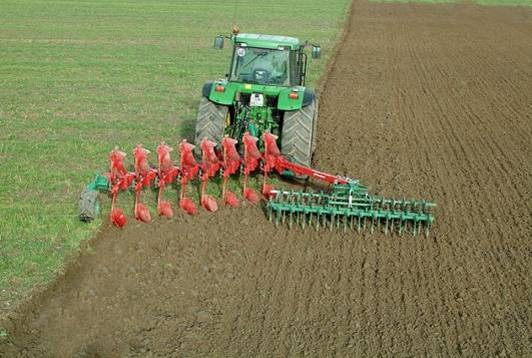
Ploug-sowing
Smoothing after sowing
Perfect tools are rollers or harrows which are connected to the sowing part of the machine. Main function of smoothing is covering the seed with soil and compressing it, to help the germination. Thereby the soil water conservation improves and it warms up sooner. Nowadays it is done together with sowing.
Control questions:
(more good answers are possible)
1. Where would you cultivate the marigold which has a Mediterranean origin?
- Humid part of the North Hungarian Mountains
- Easily warming up growing sites
- Little Hungarian Plain (Kisalföld)
- Area of the lake Balaton, with a fresh fertilized soil (manure)
- Temperature
- Water regime
- Soil nutrient content
- Wind
3. What advantages does a southern side hill have?
- Warms up faster
- It is moist
- Less windy
- Less frost-sensitive
4. Which is the least important economical factor for carraway cultivation?
- Proximity of processing place
- Cheap labour force
- Number of competitors
- Existence of storage capacity
5. Which statement is not true for crop rotation?
- Increases yield and quality
- Reduces the amount of pesticides use
- Simplifies the work organisation
- Gives protection against erosion and deflation
- Improves the soil texture
6. What is the period of rotation in medium-long crop rotation?
- 1 year
- 2-3 years
- 4-10 years
- More than 10 years
7. What advantage does the proper crop rotation have in the cultivation process?
- Reduce the weed ratio of the field
- Reduce the soil erosion
- Improve the soil water conservation
- Reduce the drying effect of the sunshine and wind
- Basil after marjoram
- Thyme after shelled pumpkin
- Poppy after peas
- Anise after coriander
9. Why is loosening important?
- Improves the air and water management of the soil
- Decreases the erosion
- The roots can progress better
- The soil warms up easier
10. In arid climate areas which primary tillage technologies can be recommended?
- Ploughing
- Middle deep and deep loosening
- Rotavate
- Use of cultivator and roller
11. When should primary tillage with turn be done?
- To allocate manure to the soil
- In arid climate areas
- To avoid hardpan
- When the quality of the subsoil is a bad
12. Which technology can not mix the soil?
- Ploughing
- Soil loosening
- Discing
- Rotavate
- It makes the soil structure friable
- It allows the wetting of topsoil
- It has a weed control effect
- Improves the soil water capacity.
14. What is a bad seed bed like?
- Have a flat surface
- Have a friable structure
- The topsoil is sufficiently compressed, sowing depth is sufficiently loose
- Weed free
- Moisty
Right answers
References
Bernáth J. (szerk.) (2000): Gyógy- és Aromanövények. Mezőgazda Kiadó, Budapest.
Radics L. (szerk.) (2006): Ökológiai gazdálkodás a felsőfokú szakképzés hallgatói számára. Szaktudás Kiadó Ház, Budapest.
Tarjányi F. (1994): Talajművelés. In: Balázs S. (szerk.): Zöldségtermesztők kézikönyve. Mezőgazda Kiadó, Budapest. 115-123.
Tarjányi F. (1994): Vetésforgó, növényváltás. In: Balázs S. (szerk.): Zöldségtermesztők kézikönyve. Mezőgazda Kiadó, Budapest. 130-137.
